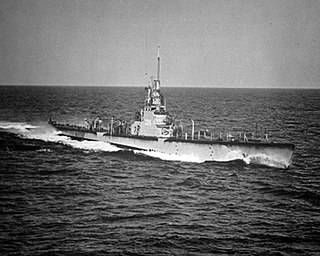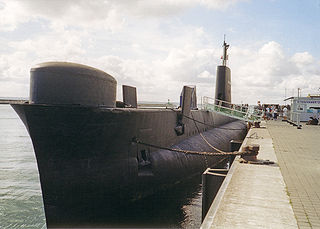
Type XXI submarines were a class of German diesel–electric Elektroboot submarines designed during the Second World War. One hundred and eighteen were completed, with four being combat-ready. During the war only two were put into active service and went on patrols, but these were not used in combat.

USS Cod (SS/AGSS/IXSS-224) is a Gato-class submarine, the only vessel of the United States Navy to be named for the cod, an important and very popular food fish of the North Atlantic and North Pacific.

The Oberon class was a ship class of 27 British-designed submarines operated by five nations. They were designed as a follow-on from the Porpoise class; physical dimensions were the same but stronger materials were used in hull construction and improved equipment was fitted.

The Project 633 class is a class of Soviet diesel-electric submarine, built between 1957 and 1961. A Chinese variant, Type 033, was built in China from 1962 to 1984.

Century Park is the biggest park in the city of Shanghai. It is situated on Jinxiu Road, in the Pudong New Area of Shanghai, nearby to the Shanghai Science and Technology Museum.

German submarine U-36 was a Type VIIA U-boat of Nazi Germany's Kriegsmarine which served during World War II. She was constructed in the earliest days of the U-boat arm at Kiel in 1936, and served in the pre-war Navy in the Baltic Sea and North Sea under Kapitänleutnant (Kptlt.) Klaus Ewerth. Korvettenkapitän (K.Kapt.)Wilhelm Fröhlich took command in October 1938 and continued in the role until the boat was lost.

The Type 062 gunboat is a class of gunboat of the People's Liberation Army Navy first developed and constructed in the 1950s. This unsophisticated class is relatively well-armed for its size and is the most widely built and exported Chinese naval vessel in terms of numbers. A total of 30 were built, initial boats being known as the Shanghai I class and later slightly improved boats being known as the Shanghai II class. The Shanghai I class was slightly smaller than its successor, the Shanghai II class, displacing 125 tons instead of 135 tons, and had a twin Chinese Type 66 57 mm gun mount forward. All other specifications are identical to the Shanghai II class, which replaced the 57 mm with twin 37 mm gun mounts. Some boats remained in active service well into the early 1990s in the PLA navy and longer in the case of the Korean People's Navy.

Project 122bis submarine chasers were a Soviet design which were exported throughout the communist bloc in the 1950s. The first ship, BO-270, was built at Zelenodolsk in 1945-1947 and a total of 227 were built for Soviet Navy (175) and border guard until 1955. As well as this, twenty Project 357 despatch vessels were built on the same hull, but were lightly armed.

The People's Liberation Army Navy Submarine Force (PLANSF) is the submarine service of the People's Liberation Army Navy. It consists of all types of submarines in operational service organized into three fleets: the North Sea Fleet, the East Sea Fleet, and the South Sea Fleet. Submarines have long been one of the three focuses of the People's Liberation Army Navy, and when the decision was made in late 2006 to concentrate on building other principal surface combatants to strengthen the air defense and to further delay the construction of aircraft carriers due to insufficient air cover, submarines will continue to play the lead dominant role in the assault force for the PLAN. Currently, PLANSF operates a fleet of 66 submarines which include nuclear as well as conventional submarines.
SM UB-26 was a German Type UB II submarine or U-boat in the German Imperial Navy during World War I. The U-boat was ordered on 30 April 1915 and launched on 14 December 1915. She was commissioned into the German Imperial Navy on 27 December 1915 as SM UB-26. UB-26 was trapped in anti-submarine nets trailed by the French destroyer Trombe and was scuttled in Le Havre harbour on 5 April 1916. She was raised by the French on 30 August 1917 and served as Roland Morillot.

German submarine U-121 was a long-lived Type IIB U-boat built during World War II for service in Nazi Germany's Kriegsmarine. U-121 spent the entire war as a training vessel and was scuttled at the end of the conflict.
German submarine U-632 was a Type VIIC U-boat of Nazi Germany's Kriegsmarine during World War II. The submarine was laid down on 4 September 1941 at the Blohm & Voss yard at Hamburg, launched on 27 May 1942, and commissioned on 23 July 1942 under the command of Oberleutnant zur See Hans Karpf.
The Type 035 submarine is a class of diesel-electric submarines of the People's Liberation Army Navy. The Type 035 is a heavily improved redesign of the older Type 033 submarines, which were built in China from 1962 to 1984.
German submarine U-719 was a Type VIIC U-boat of Nazi Germany's Kriegsmarine during World War II. The submarine was laid down on 3 July 1942 at the H. C. Stülcken Sohn yard at Hamburg, launched on 28 April 1943, and commissioned on 27 July 1943 under the command of Oberleutnant zur See Klaus-Dietrich Steffens. Attached to 5th U-boat Flotilla based at Kiel, U-719 completed her training period on 30 April 1944 and was assigned to front-line service.

I-121, laid down in 1924 as Submarine No. 48 and known as I-21 from November 1924 to June 1938, was an I-121-class submarine of the Imperial Japanese Navy that served during the Second Sino-Japanese War and World War II. During the latter conflict, she conducted operations in support of the Japanese invasion of Malaya, the Japanese invasion of the Philippines, the bombing of Darwin, the Battle of Midway, the Guadalcanal campaign, the Battle of the Eastern Solomons, and the New Guinea campaign. She surrendered at the end of the war in 1945 and was scuttled in 1946.

Changcheng 237 is a Type 033 submarine of the People's Liberation Army Navy.
Changcheng 303 is a Type 033 submarine of the People's Liberation Army Navy.
Changcheng 349 is a Type 033 submarine of the People's Liberation Army Navy.
Changcheng 279 is a Type 033 submarine of the People's Liberation Army Navy.
Changcheng 353 is a Type 035 submarine of the People's Liberation Army Navy.











